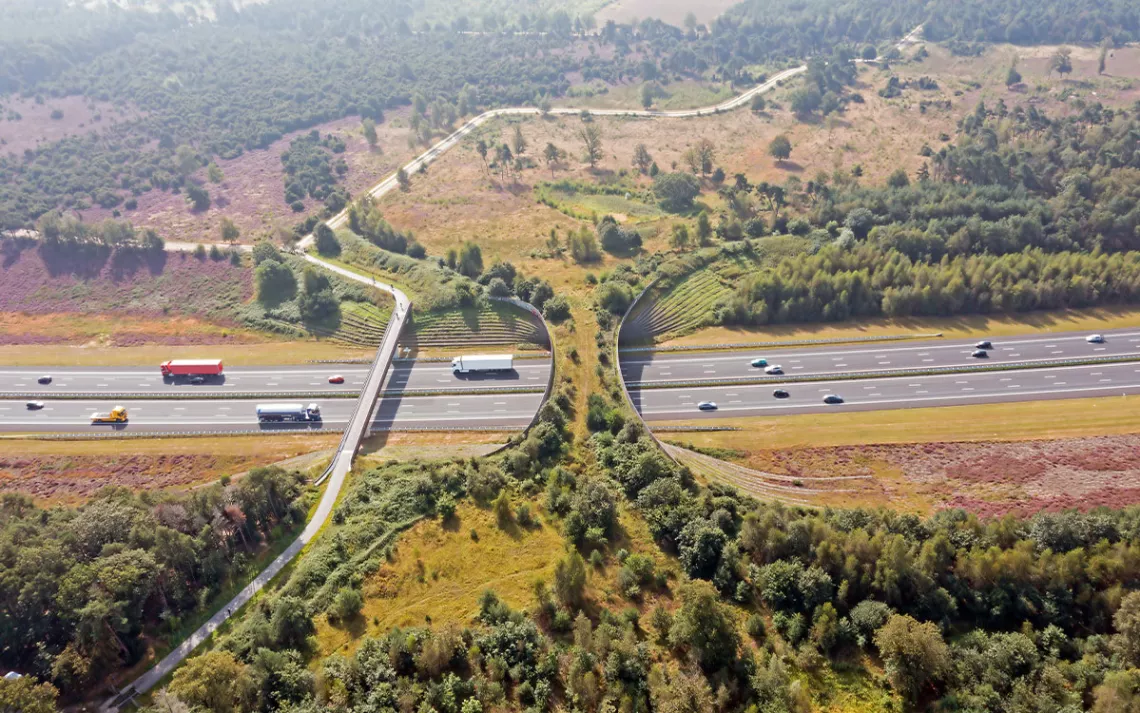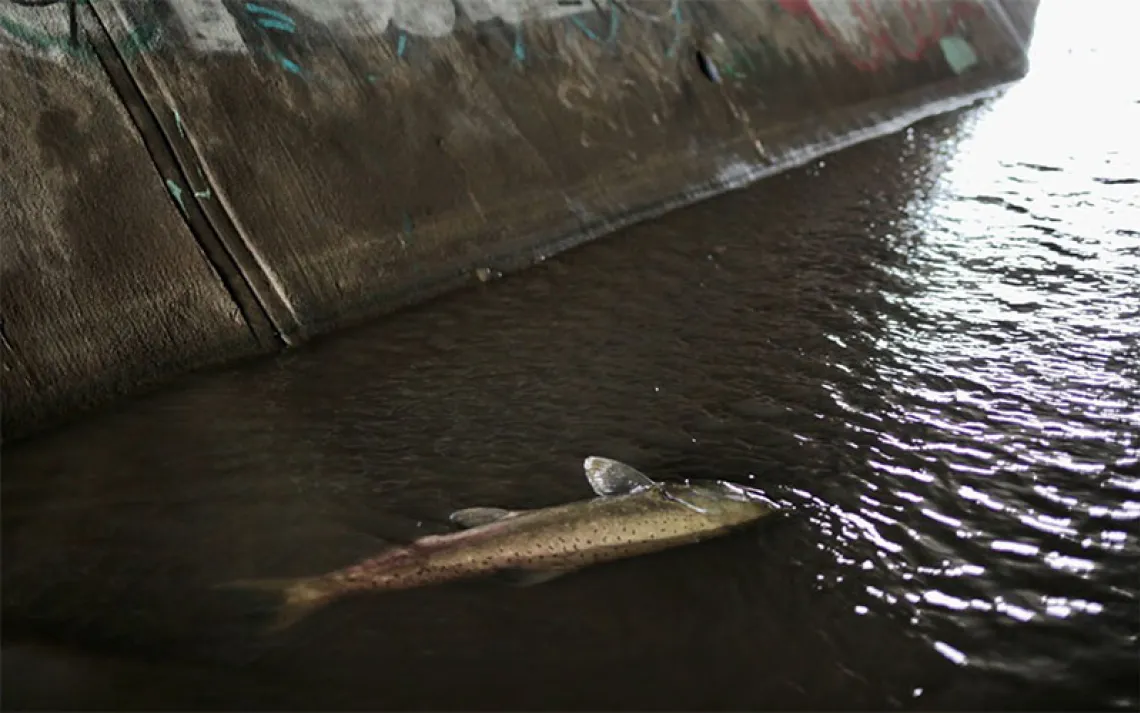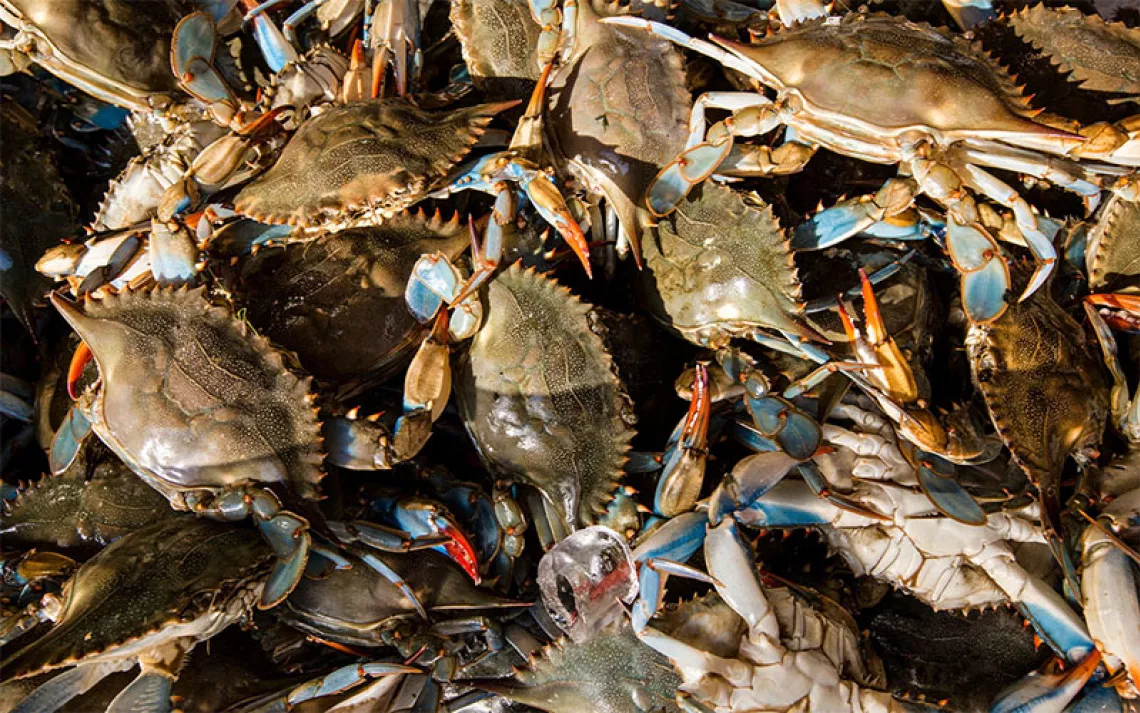Wildlife Crossings Can Mend a Landscape
Badgers and hedgehogs need protection from traffic as much as lions and bears

De Borkeld ecoduct on the A1 highway in Rijssen, the Netherlands. | Photo by Nisangha/iStock
It’s a cloudy morning in the Netherlands, and a lone female roe deer saunters across the Zanderij Crailoo Nature Bridge, the longest wildlife crossing in the world. This half-mile-long overpass connects a forested area on one side to a stretch of open, uncultivated land on the other. A few minutes later, a red fox scampers along the bridge.
The overpass and others like it allow animals to roam large distances freely, without the risk of becoming roadkill. For more than three decades, the Netherlands has used them to reduce habitat fragmentation and improve connectivity for wildlife. It has built a wide variety of crossing structures, either above or below roads and railways and at waterways. This tiny nation, less than twice the size of Massachusetts, has nearly 3,000 crossings in place.
Vegetated overpasses facilitate the movement of red foxes, roe deer, red deer, fallow deer, wild boar, and other large mammals, while smaller tunnels enable the movement of otters, badgers, stoats, pine martens, weasels, hedgehogs, snakes, and amphibians. Many of these species are locally or nationally endangered. Wildlife crossings provide them with access to food, mates, and new habitat, aiding in their long-term conservation.
As one of the most densely populated countries in the world, the Netherlands is crammed with people, houses, farms, roads, railways, and waterways. The landscape’s severe fragmentation led to a high rate of roadkill. Edgar van der Grift, a senior research ecologist at Wageningen University in the Netherlands, cites a 1959 Dutch study that found that cars and trucks were killing large numbers of mammals: badgers, hedgehogs, red squirrels, weasels, deer, wild boar, and many others. “For roe deer,” he says, “it was mentioned that in one area, 25 percent of the population was killed on the roads each year.”
The shocking numbers of roadkill spurred Dutch conservation organizations and government authorities into action, and the first wildlife crossing in the country—a badger tunnel—was built in 1974. Several ad hoc efforts followed, leading up to the Nature Policy Plan of 1990, a huge step forward in protecting the last few remaining natural areas in the country. But just a decade later the plan was already found to be inadequate: Modeling showed that its measures were not sufficient to conserve a large number of target species. In 2005, a more concerted effort was launched—the Meerjarenprogramma Ontsnippering (MJPO), a multiyear, multiagency nationwide defragmentation effort.
The MJPO evaluated over 1,100 problematic locations, and by the end of 2018, more than 500 overpasses (or bridges), underpasses, tunnels, culverts, and other kinds of structures had been built at 178 locations. In some cases, multiple measures were undertaken at one location. “Thinking about mitigating the ecological effects of existing roads and doing that in a systematic way—very few countries have done that,” says Van der Grift. “That’s rather unique about the Netherlands.”
In Van der Grift’s experience, if the location of the crossing is carefully chosen, the structure is well designed, and any additional measures—like fences or modified vegetation to funnel animals into the crossing—are addressed, animals have no trouble finding and using a crossing. “In general, we see that these bridges and tunnels are used rather quickly,” he says, “especially by mobile species that walk several kilometers every day.” An analysis conducted by Van der Grift and his colleagues showed that a crossing structure coupled with fencing helped reduce large mammal roadkill by a staggering 83 percent, although he notes that more research is needed.
Since 2000, Dutch law has mandated an environmental impact assessment (EIA) for all new roads, railways, and other infrastructure projects. If the EIA of a potential project indicates a mitigation measure, it is incorporated into the project’s design from the start.
Adam Hofland is the program manager at Rijkswaterstaat, the implementation arm of the Dutch Ministry of Infrastructure and Water Management. “If we want to maintain [these structures’] function, we also need to spend money and energy on their maintenance,” Hofland says, noting as an example that a badger tunnel needs to be inspected several times a year, and cleaned, if required. “Badgers don’t like to have wet feet,” he says. “If there is water inside a tunnel, the badger won’t use it.” Hofland also mentions butterflies and their preference for open, grassy landscapes. This necessitates the regular trimming of trees and shrubs on a wildlife bridge.
With decades of experience in defragmenting landscapes, the Netherlands has a lot it could teach other countries. In the United States, legislation on wildlife crossings has only recently been passed at the federal and state levels. Under the Infrastructure Investment and Jobs Act of 2021, $350 million has been set aside for the Wildlife Crossings Pilot Program, which over a period of five years will fund state transportation authorities, federal agencies, tribal nations, and others to evaluate the need for and build wildlife crossings in their respective areas. At least 10 states have enacted legislation on habitat connectivity in recent years.
Despite this progress, Marcel Huijser, a senior research ecologist at the Western Transportation Institute in Montana, worries that defragmentation is still not a sufficient priority in the United States. “Even though we have world-class examples of mitigation measures in North America,” he says, “they’re not the result of having a high level of institutionalization of ecological concerns within transportation agencies.” On the contrary, he says, mitigation measures have happened largely due to power structures or the legal positions of stakeholders, like the tribal nations.
He cites the example of Highway 93 in Montana, a part of which traverses the Flathead Indian Reservation, home of the Confederated Salish and Kootenai Tribes. The expansion of this busy and dangerous route from two lanes to four lanes was put on hold for nearly a decade after the initial plans by the state transportation department were vetoed by the tribal nation authorities for not factoring in the project’s impact on the community, wildlife, and the landscape as a whole. In 2000, a context-sensitive landscape architect firm was brought on board that agreed to include wildlife crossings and other mitigation measures. In less than a year, the tribal nation and the state and federal authorities had reached an agreement.
Despite Huijser’s worries about the insufficient prioritization of the environmental impact of infrastructure projects, he remains hopeful. “There’s a lot happening on the ground,” he says, but “we need to do a better job of institutionalizing ecological concerns from the earliest planning stages.” Then possibly US wildlife crossings might rival the Netherlands’ badger boulevards.
 The Magazine of The Sierra Club
The Magazine of The Sierra Club



